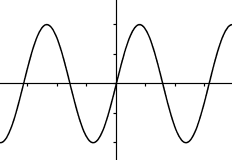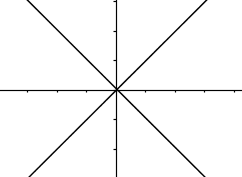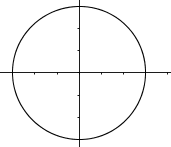Hints will display for most wrong answers; explanations for most right answers. You can attempt a question multiple times; it will only be scored correct if you get it right the first time. To see ten new questions, reload the page.
I used the official objectives and sample test to construct these questions, but cannot promise that they accurately reflect what’s on the real test. Some of the sample questions were more convoluted than I could bear to write. See terms of use. See the MTEL Practice Test main page to view questions on a particular topic or to download paper practice tests.
MTEL General Curriculum Mathematics Practice
Question 1 |
Which of the numbers below is a fraction equivalent to \( 0.\bar{6}\)?
\( \large \dfrac{4}{6}\) Hint: \( 0.\bar{6}=\dfrac{2}{3}=\dfrac{4}{6}\) | |
\( \large \dfrac{3}{5}\) Hint: This is equal to 0.6, without the repeating decimal. Answer is equivalent to choice c, which is another way to tell that it's wrong. | |
\( \large \dfrac{6}{10}\) Hint: This is equal to 0.6, without the repeating decimal. Answer is equivalent to choice b, which is another way to tell that it's wrong. | |
\( \large \dfrac{1}{6}\) Hint: This is less than a half, and \( 0.\bar{6}\) is greater than a half. |
Question 2 |
The "houses" below are made of toothpicks and gum drops.

Which of the following does not represent the number of gumdrops in a row of h houses?
\( \large 2+3h\) Hint: Think of this as start with 2 gumdrops on the left wall, and then add 3 gumdrops for each house. | |
\( \large 5+3(h-1)\) Hint: Think of this as start with one house, and then add 3 gumdrops for each of the other h-1 houses. | |
\( \large h+(h+1)+(h+1)\) Hint: Look at the gumdrops in 3 rows: h gumdrops for the "rooftops," h+1 for the tops of the vertical walls, and h+1 for the floors. | |
\( \large 5+3h\) Hint: This one is not a correct equation (which makes it the correct answer!). Compare to choice A. One of them has to be wrong, as they differ by 3. |
Question 3 |
The speed of sound in dry air at 68 degrees F is 343.2 meters per second. Which of the expressions below could be used to compute the number of kilometers that a sound wave travels in 10 minutes (in dry air at 68 degrees F)?
\( \large 343.2\times 60\times 10\) Hint: In kilometers, not meters. | |
\( \large 343.2\times 60\times 10\times \dfrac{1}{1000}\) Hint: Units are meters/sec \(\times\) seconds/minute \(\times\) minutes \(\times\) kilometers/meter, and the answer is in kilometers. | |
\( \large 343.2\times \dfrac{1}{60}\times 10\) Hint: Include units and make sure answer is in kilometers. | |
\( \large 343.2\times \dfrac{1}{60}\times 10\times \dfrac{1}{1000}\) Hint: Include units and make sure answer is in kilometers. |
Question 4 |
Use the solution procedure below to answer the question that follows:
\( \large {\left( x+3 \right)}^{2}=10\)
\( \large \left( x+3 \right)\left( x+3 \right)=10\)
\( \large {x}^{2}+9=10\)
\( \large {x}^{2}+9-9=10-9\)
\( \large {x}^{2}=1\)
\( \large x=1\text{ or }x=-1\)
Which of the following is incorrect in the procedure shown above?
The commutative property is used incorrectly.Hint: The commutative property is \(a+b=b+a\) or \(ab=ba\). | |
The associative property is used incorrectly.Hint: The associative property is \(a+(b+c)=(a+b)+c\) or
\(a \times (b \times c)=(a \times b) \times c\). | |
Order of operations is done incorrectly. | |
The distributive property is used incorrectly.Hint: \((x+3)(x+3)=x(x+3)+3(x+3)\)=\(x^2+3x+3x+9.\) |
Question 5 |
Solve for x: \(\large 4-\dfrac{2}{3}x=2x\)
\( \large x=3\) Hint: Try plugging x=3 into the equation. | |
\( \large x=-3\) Hint: Left side is positive, right side is negative when you plug this in for x. | |
\( \large x=\dfrac{3}{2}\) Hint: One way to solve: \(4=\dfrac{2}{3}x+2x\) \(=\dfrac{8}{3}x\).\(x=\dfrac{3 \times 4}{8}=\dfrac{3}{2}\). Another way is to just plug x=3/2 into the equation and see that each side equals 3 -- on a multiple choice test, you almost never have to actually solve for x. | |
\( \large x=-\dfrac{3}{2}\) Hint: Left side is positive, right side is negative when you plug this in for x. |
Question 6 |
Which of the following is closest to the height of a college student in centimeters?
1.6 cmHint: This is more the height of a Lego toy college student -- less than an inch! | |
16 cmHint: Less than knee high on most college students. | |
160 cmHint: Remember, a meter stick (a little bigger than a yard stick) is 100 cm. Also good to know is that 4 inches is approximately 10 cm. | |
1600 cmHint: This college student might be taller than some campus buildings! |
Question 7 |
Here are some statements:
I) 5 is an integer II)\( -5 \) is an integer III) \(0\) is an integer
Which of the statements are true?
I only | |
I and II only | |
I and III only | |
I, II, and IIIHint: The integers are ...-3, -2, -1, 0, 1, 2, 3, .... |
Question 8 |
Which of the following is equivalent to \( \dfrac{3}{4}-\dfrac{1}{8}+\dfrac{2}{8}\times \dfrac{1}{2}?\)
\( \large \dfrac{7}{16}\) Hint: Multiplication comes before addition and subtraction in the order of operations. | |
\( \large \dfrac{1}{2}\) Hint: Addition and subtraction are of equal priority in the order of operations -- do them left to right. | |
\( \large \dfrac{3}{4}\) Hint: \( \dfrac{3}{4}-\dfrac{1}{8}+\dfrac{2}{8}\times \dfrac{1}{2}\)=\( \dfrac{3}{4}-\dfrac{1}{8}+\dfrac{1}{8}\)=\( \dfrac{3}{4}+-\dfrac{1}{8}+\dfrac{1}{8}\)=\( \dfrac{3}{4}\) | |
\( \large \dfrac{3}{16}\) Hint: Multiplication comes before addition and subtraction in the order of operations. |
Question 9 |
Which of the graphs below represent functions?
I. II.
II.  III.
III.  IV.
IV. 
I and IV only.Hint: There are vertical lines that go through 2 points in IV . | |
I and III only.Hint: Even though III is not continuous, it's still a function (assuming that vertical lines between the "steps" do not go through 2 points). | |
II and III only.Hint: Learn about the vertical line test. | |
I, II, and IV only.Hint: There are vertical lines that go through 2 points in II. |
Question 10 |
A family has four children. What is the probability that two children are girls and two are boys? Assume the the probability of having a boy (or a girl) is 50%.
\( \large \dfrac{1}{2}\) Hint: How many different configurations are there from oldest to youngest, e.g. BGGG? How many of them have 2 boys and 2 girls? | |
\( \large \dfrac{1}{4}\) Hint: How many different configurations are there from oldest to youngest, e.g. BGGG? How many of them have 2 boys and 2 girls? | |
\( \large \dfrac{1}{5}\) Hint: Some configurations are more probable than others -- i.e. it's more likely to have two boys and two girls than all boys. Be sure you are weighting properly. | |
\( \large \dfrac{3}{8}\) Hint: There are two possibilities for each child, so there are \(2 \times 2 \times 2 \times 2 =16\) different configurations, e.g. from oldest to youngest BBBG, BGGB, GBBB, etc. Of these configurations, there are 6 with two boys and two girls (this is the combination \(_{4}C_{2}\) or "4 choose 2"): BBGG, BGBG, BGGB, GGBB, GBGB, and GBBG. Thus the probability is 6/16=3/8. |
If you found a mistake or have comments on a particular question, please contact me (please copy and paste at least part of the question into the form, as the numbers change depending on how quizzes are displayed). General comments can be left here.